- Facts and Figures
- Social Security Statistics
- Social Media Statistics
- Cell Phone Usage Statistics
- Cryptocurrency Statistics
- White Collar Crime Statistics
- Crowdfunding Statistics
- Branding Statistics
- How Many Emails Are Sent Per Day
- Money Laundering Statistics
- Childcare Availability Statistics
- Cold Calling Statistics
- Automation And Job Loss Statistics
- Student Loan Statistics
- Spam Statistics
- Password Statistics
- Ransomware Statistics
- Christmas Spending Statistics
- Average Grocery Cost By State
- Average Screen Time Statistics
- Average Monthly Expenses
- IoT Statistics
- Gen Z Statistics
Research Summary. Across the United States, child care accessibility places a large burden on the economy and the labor force. Now, closures and mandates brought on by the global pandemic are causing increased hardship when it comes to finding quality child care. After extensive research, our data analysis team concluded:
-
57% of working families spent more than $10,000 on child care in 2020.
-
51% of Americans live in communities classified as child care deserts.
-
On average, two-income American households with children spend at least 10% of their household income on child care.
-
58% of working parents rely on child care centers — that’s about 6.38 million parents across the nation.
-
The child care industry in the United States is valued at $60.4 billion.
-
Annual economic losses because of child care translate to $21 billion in lost tax revenue, $23 billion in lost business revenue, and $78 billion in lost individual earnings.
For further analysis, we broke down the data in the following ways:
Women in the Workplace | The Industry | Costs | The Pandemic | Availability by Demographics | Availability by Region
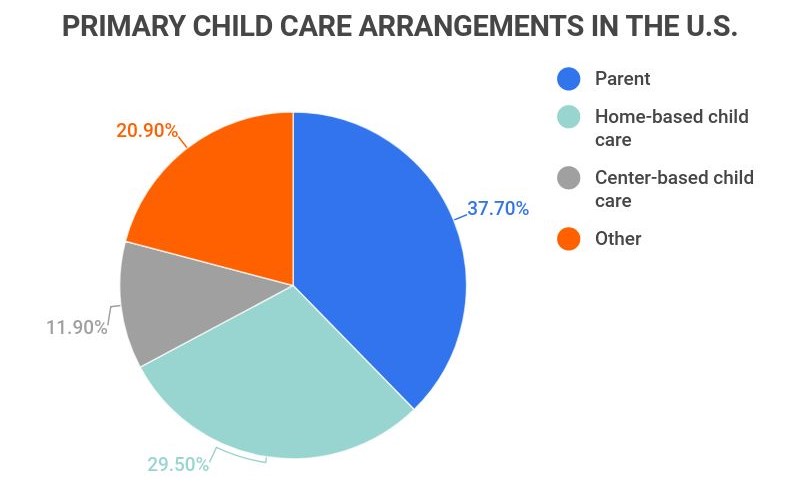
General Child Care Statistics
-
27% of families who have difficulty accessing child care cannot find an open child care slot.
Roughly half of Americans have trouble finding child care, and 27% of them say it’s because there are not enough open child care slots. As a result, two-thirds of parents in the U.S. have very few — often only one — child care options.
-
On average, it costs $340 per week to send a child to a child care or daycare center.
In the United States, it costs $300 per week to send a child to a family care center, $340 per week to send a child to a child care or daycare center, and $612 per week for a nanny, as reported by the Center for American Progress.
The cost of sending two children to a child care center jumps considerably to $640, with the weekly cost for a nanny coming in at roughly $654.
-
31.7% of U.S. children under the age of five cannot access a childcare slot.
According to a 2020 study that analyzed 25 states across the nation, 8.4 million children under the age of five needed child care. However, only about 5.9 million child care slots were available. Thus, roughly 2.7 million children, or 31.7%, could not access quality child care due to a limited number of child care slots.
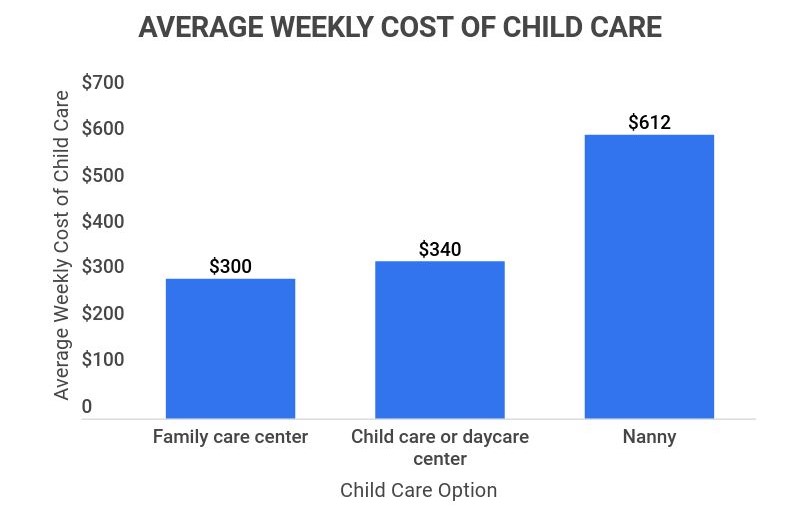

Child Care Statistics and Women in the Workplace
-
Child care is more likely to impact a mother’s career than it is to impact a father’s career.
Mothers with young children are 40% more likely than fathers to report that child care issues have negatively impacted their careers, according to a survey conducted by the Center for American Progress.
-
About 20% of stay-at-home mothers would enter the workforce if they had child care assistance.
20% of mothers who do not currently work would look for a job if they had better access to quality child care.
An additional 42% of working mothers would look for a higher-paying job, and 29% of working mothers would seek additional schooling or training to help them advance in their careers.
-
The cost of child care has led to a 13% decline in the employment of mothers.
Over the past two decades, women’s participation in the labor force has been declining, and rising child care costs are partly to blame. The United States’ lack of federal child care and paid family leave policies is tied to at least one-third of the decline in female employment.
-
69% of young mothers work in the United States.
Nearly 70% of young mothers participate in the labor force, according to the CAP. The center also found that fewer mothers in the workforce are directly associated with child care deserts.
-
About 42% of mothers are sole or primary breadwinners for their household.
Overall, 70% of American mothers participate in the labor force, and roughly 42% of them are the sole or primary breadwinners in their homes. This rate is even higher among Black mothers, with 71% of them serving as the sole or primary breadwinners for their household.
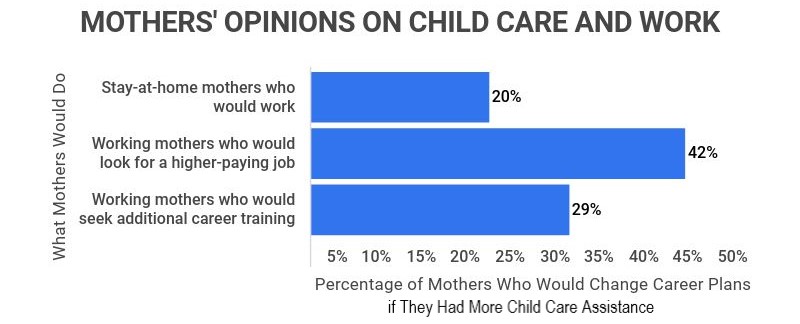
Child Care Statistics: The Industry
-
Roughly 30% of infants and toddlers go to home-based child care facilities.
In the United States, 29.5% of infants and toddlers attend home-based child care facilities. Meanwhile, 37.7% of infants and toddlers are exclusively cared for by a parent or guardian.
-
52% of home-based child care is unpaid.
The majority of home-based child care that isn’t with a parent involves the unpaid help of friends, family members, and neighbors. Overall, this sort of unpaid child care accounts for the primary care experience of 15.4% of infants and toddlers in the U.S.
Meanwhile, 48% of home-based child care is paid — either to a provider with whom the parents had a previous relationship (friends, family, neighbors, etc.) or a paid provider with whom the parents have no previous relationship (a professional sitter, nanny, etc.)
Overall, 7.2% of infants and toddlers in the U.S. are provided for by paid family, friends, and neighbors, while 7% are covered by a paid, professional child care provider.
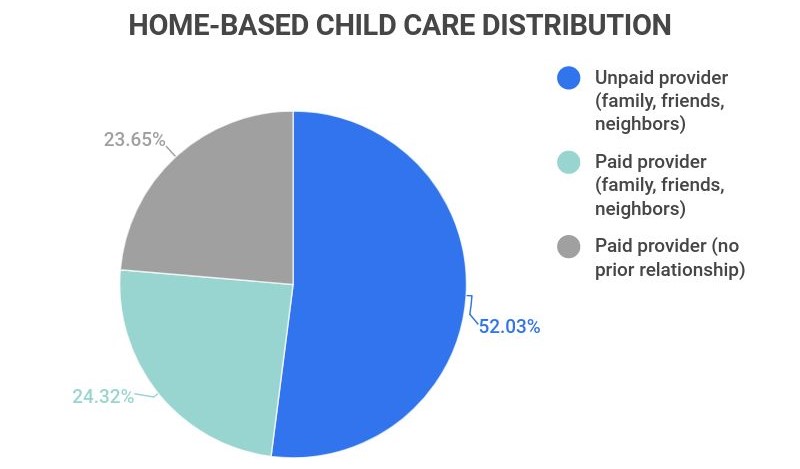
-
58% of working parents rely on child care centers.
58% of working parents with children five years old and younger — or about 6.38 million parents across the nation — use center-based child care options, according to estimates from the National Household Education Survey.
The survey also found that of the 11 million working parents in the U.S., 31% of them do not rely on any outside child care, 25% of them rely on non-relatives for child care, and 47% rely on relatives for child care.
-
U.S. businesses lose, on average, $12.7 billion each year due to child care challenges.
Data shows that employees with children three years old and younger cost their employers roughly $1,150 per year because of inadequate child care. With 11 million working parents across the U.S., this equates to a total business loss of $12.7 billion.
-
There are over 600,000 daycares in the U.S.
As of 2022, the number of daycares in the U.S. was estimated to be 634,528. These companies employ approximately 1.5 million people.
Child Care Statistics by Costs
-
The majority of working parents have reduced their work hours, at some point, for their kids.
As a result of child care problems, 63% of working parents have left work earlier than normal, 56% of working parents have been late for work, 55% of working parents have missed a full day of work, and 54% of working parents have reported being distracted at work, according to data published by Ready Nation.
In addition, of the parents surveyed, one in five of them said they have been reprimanded at least once by a supervisor, and one in seven of them said they have had their pay or hours reduced as a result of child care affecting their productivity levels at work.
-
More than half of U.S. families spent more than $10,000 on child care in 2020.
57% of families across the United States spent more than $10,000 on child care last year, according to a survey by Care.com. In 2021, 59% of families are budgeting to spend more than $10,000 in yearly child care costs.
These numbers make child care more expensive than college, with the average in-state tuition ringing up at $9,580 annually.
-
The current child care system places a $98 billion burden on the U.S. economy.
Working parents lose an estimated $8,940 each year in lost earnings, reduced participation in the workforce, and lower returns on professional experience, according to data reported by Ready Nation.
Across the nation, there are approximately 11 million working parents with children under the age of three. As such, the current child care system results in a total average annual economic cost of $98 billion.
-
The average in-home child care rates per week are $300.
This is the average weekly cost of a home-based family care center, while a nanny costs $612 per week, on average.
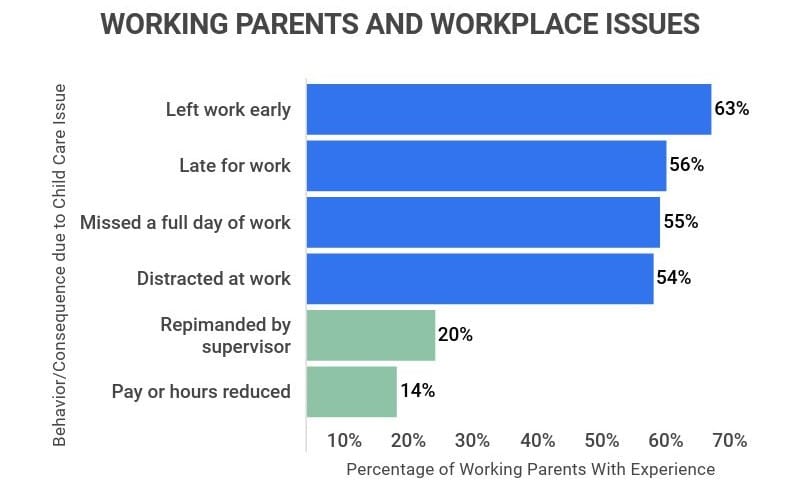
Child Care Statistics and the Pandemic
-
The United States is on track to permanently lose up to 4.5 million child care slots due to the pandemic.
More than 4 million child care slots could be lost in the coming months due to COVID-19, according to Teach for America. Moreover, the large majority of these lost slots will affect low-income families and people of color.
-
Prior to the pandemic, at least two-thirds of U.S. families relied on some form of child care.
Before the pandemic, the majority of parents with children under the age of six worked and thus relied on child care to some extent. About 22% of all parents with young children say that they cannot work, either in person or remotely, without child care.
-
Child care is more expensive now compared to before the pandemic.
72% of families say that child care is more expensive than it was before the global COVID-19 pandemic, according to a Care.com study. Meanwhile, only 6% of families report that it is less expensive.
Increased costs are widely due to the elevated safety precautions that have been put in place at child care centers across the nation.
-
Quality child care is much harder to find now compared to before the pandemic.
Roughly 46% of families in the United States said that they have a harder time finding child care now compared to pre-pandemic. As such, many families are turning to nannies instead of daycare centers for their child care needs.
Today, the cost of hiring a nanny is only $14 more per week than the cost of having two kids in a child care center. In 2019, it cost $239 more weekly to hire a nanny.
-
Almost 16,000 child care providers permanently closed during the COVID-19 pandemic.
Between December 2019 and March 2021, these companies closed down as many others did, but they never reopened.
-
According to Care.com, of the 51% of American families who used child care or daycare center before the pandemic, 61% say that the center is not yet fully open and operating. An additional 14% of survey families who used child care centers before the pandemic said that their child care provider is open, but not fully.
-
62% of families are more concerned about the cost of child care now compared to before the pandemic.
Compared to pre-pandemic, 62% of families are more concerned, while 10% of families are less concerned about the cost of child care. Of the 62% who are more concerned, 43% said it was because of the increased cost of child care due to safety protocols, and 32% said it was because they had to shift to a different child care arrangement.
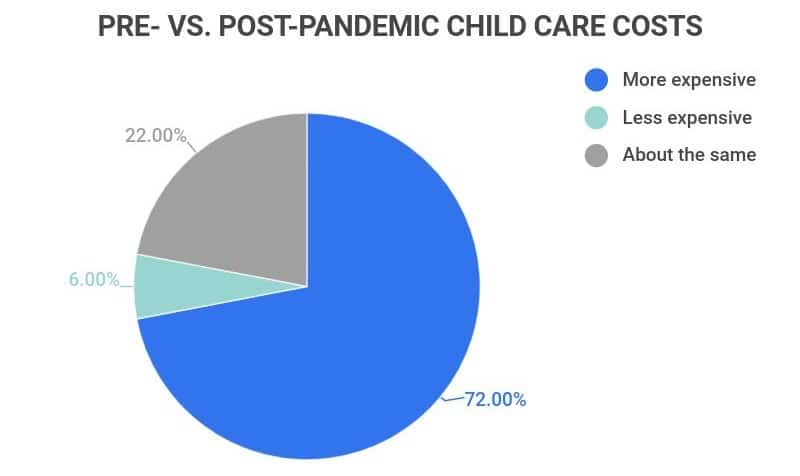
Child Care Statistics: Availability by Demographics
-
About half of all American families have trouble finding child care, and that number varies by race and income.
In the United States, roughly 44% of Black families, 50% of White families, and 57% of Hispanic families live in a child care desert and thus have a harder time finding child care.
Among higher-income neighborhoods, only 43% of families struggle to find child care. This is compared to 54% of families who live in lower-income neighborhoods and have a hard time accessing child care.
-
More than 70% of mothers in the United States work.
According to labor statistics, in 2020, 71.2% of mothers with children under the age of 18 participated in the labor force. This number was down from 72.3% in 2019. For comparison, in 2020, 92.3% of fathers with children under the age of 18 participated in the labor force.
-
Black mothers have the highest rates of workforce participation out of all mothers in the United States.
According to numbers released by American Progress, 80% of Black women with children aged six through 17 work — the highest rate of all other racial and ethnic groups analyzed. In addition, the labor force participation rate for Black women has increased by 23% since 1989.
Child Care Statistics: Availability by Region
-
Child care is harder to access in the Western United States and rural areas.
In small towns and rural areas across the nation, roughly 26% of families report that finding a child care provider is very difficult. For comparison, only 10% of families who live in the suburbs and 11% of families who live in major cities report having a very difficult time finding a quality child care provider.
In addition, an estimated 20% of families in the Western United States lost their child care provider, either because they are permanently closed or unavailable, due to the pandemic.
-
Quality child care is especially hard to come by in Utah, Nevada, Hawaii, West Virginia, and New York.
Utah, Nevada, Hawaii, West Virginia, and New York have the highest rates of child care deserts by the state in the United States. Data shows that 77% of families in Utah, 72% of families in Nevada, 68% of families in Hawaii, and 64% of families in West Virginia and New York live in a child care desert.
Child Care Statistics FAQ
-
What are child care deserts?
Child care deserts refer to areas in the United States with little to no access to quality child care. Data suggests that more than half of all American families reside in child care deserts and, in some states, as many as two-thirds of families have limited access to child care.
Most areas are classified as a child care desert if more than 50 children under the age of five reside there, and there are more than three times as many children as there are licensed child care slots.
-
Are there any proposed policy solutions to make child care more accessible and affordable?
Yes, some states have proposed budgets and legislations to provide child care benefits to working families. A federal comprehensive early childhood policy, the Child Care for Working Families Act, has been proposed in congress.
If passed, this policy would serve several million children across the United States, allow families with at least two children in child care to save more than $10,000 annually, and help to increase economic activity in at least 36 states by an estimated $1 billion each.
-
How many children attend child care in the U.S.?
-
What is the average cost of daycare in the U.S.?
The average cost of daycare in the U.S. is $340 per week. This works out to an annual cost of $17,680 per child if they are in daycare year-round.
Roughly 27.1% of infants and toddlers in the U.S. attended some form of paid child care as their primary care arrangement. 11.9% of children attended a child care or daycare center, while 7.2% received care from a paid family member/friend/neighbor, and another 7% received primary care from a paid professional with no prior relationship with the parents.
However, this survey was published in 2019, pre-pandemic. With many daycare centers closing or limiting operations, it’s likely that this percentage has dropped off, while paid at-home providers have become more common.
Conclusion
There’s no question that quality child care — that is both accessible and affordable — is an integral aspect of both the U.S. economy and the livelihood of families across the nation. However, after analyzing the numbers, it seems the current system is not only failing parents but also shorting employers and placing an overwhelming burden on America’s economy.
With more than half of all working families spending a whopping $10,000 a year on child care or roughly 10% of their household income, it’s no surprise that child care is leading to $21 billion in lost tax revenue, $23 billion in lost business revenue, and $78 billion in lost individual earnings across the nation.
Although COVID-19 shutdowns may generally be past us, the pandemic continues to place added hardships on parents when it comes to affording and finding child care, an industry valued at $60.4 billion. Now, the availability and affordability of quality child care could largely depend on the success of various federal legislations.
References
-
Ready Nation. “The Economic Impacts Of Insufficient Child Care On Working Families.” Accessed on August 26, 2021.
-
Care.com. “This Is How Much Child Care Costs In 2021.” Accessed on August 26, 2021.
-
Center for American Progress. “51 Percent Of People In The United States Live In A Child Care Desert.” Accessed on August 26, 2021.
-
Center for American Progress. “The Child Care Crisis Is Keeping Women Out Of The Workforce.” Accessed on August 26, 2021.
-
Teach for America. “The Coming Child Care Crisis.” Accessed on August 26, 2021.
-
Bureau Of Labor Statistics. “Employment Characteristics Of Families — 2020.” Accessed on August 26, 2021.
-
Center for American Progress. “The State Of The U.S. Labor Market For Mothers: Pre-May 2018 Jobs Release.” Accessed on August 26, 2021.
-
Child Trends. “Nearly 30 Percent Of Infants And Toddlers Attend Home Based Child Care As Their Primary Arrangement.” Accessed on August 26, 2021.
-
Bipartisan Policy Center. “Child Care In 25 States: What We Know And Don’t Know.” Accessed on August 26, 2021.
-
Council for a Strong America. “$122 Billion: The Growing, Annual Cost of the Infant-Toddler Child Care Crisis.” Accessed on February 16, 2023.
-
Grand View Research. “U.S. Child Care Market Size, Share and Growth Report, 2030.” Accessed on February 16, 2023.
-
IBIS World. “Day Care Industry in the U.S. – Market Research Report.” Accessed on February 20, 2023.
-
Fortune. “16,000 Childcare Providers Shut Down in the Pandemic. It’s a Really Big Deal.” Accessed on February 20, 2023.
- Facts and Figures
- Social Security Statistics
- Social Media Statistics
- Cell Phone Usage Statistics
- Cryptocurrency Statistics
- White Collar Crime Statistics
- Crowdfunding Statistics
- Branding Statistics
- How Many Emails Are Sent Per Day
- Money Laundering Statistics
- Childcare Availability Statistics
- Cold Calling Statistics
- Automation And Job Loss Statistics
- Student Loan Statistics
- Spam Statistics
- Password Statistics
- Ransomware Statistics
- Christmas Spending Statistics
- Average Grocery Cost By State
- Average Screen Time Statistics
- Average Monthly Expenses
- IoT Statistics
- Gen Z Statistics






